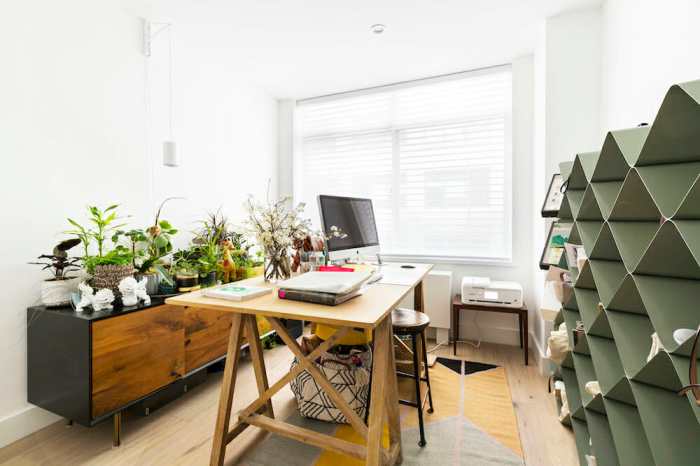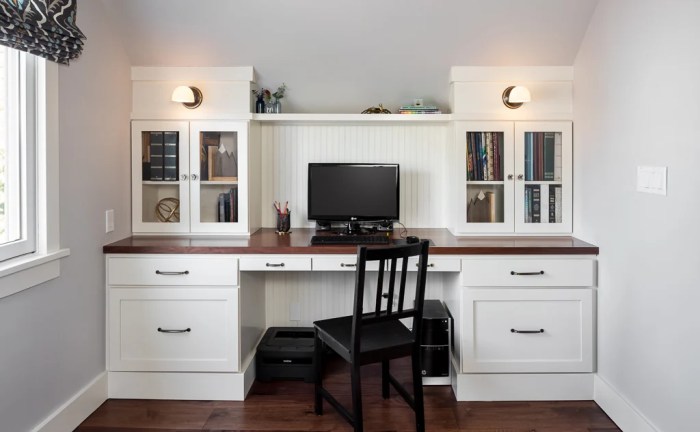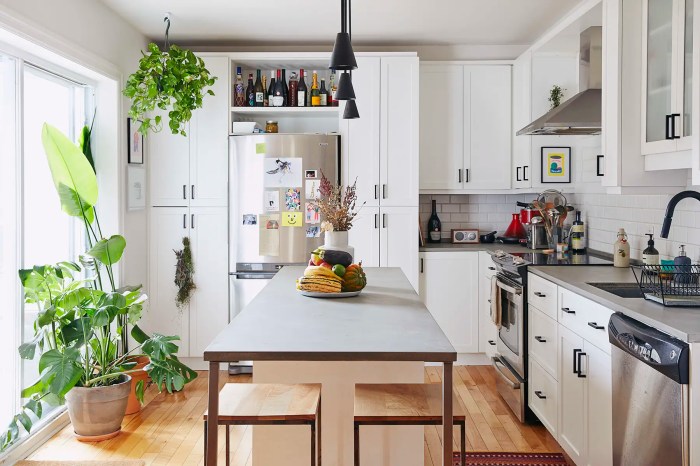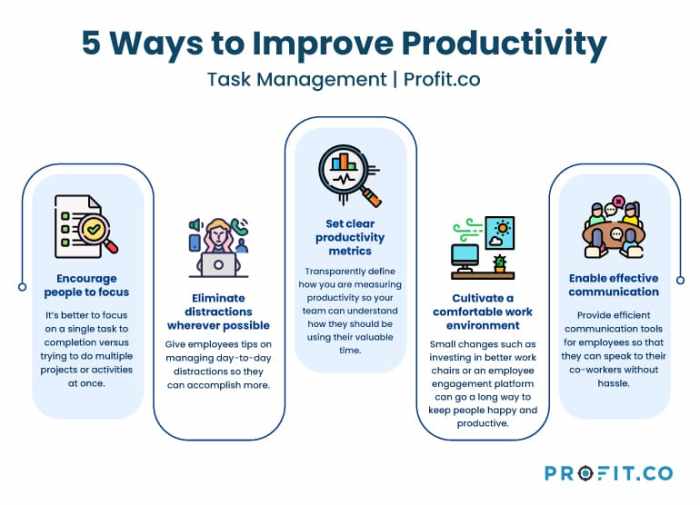
Transforming your home into a haven of productivity starts with planning a dedicated workspace. Integrating a home office during a renovation project offers a unique opportunity to create a space tailored to your needs and aspirations. From maximizing natural light to incorporating smart technology, the possibilities are endless.
This guide will walk you through the process of planning, designing, and integrating a home office into your renovation project, ensuring a functional and inspiring environment for your work life.
Planning Your Home Office Space

Adding a home office space during a renovation offers a unique opportunity to create a dedicated and functional workspace that suits your individual needs and preferences. This is your chance to design a space that optimizes your productivity and inspires creativity.
The Importance of Considering Your Workflow and Needs
The success of your home office depends on a thoughtful design process that prioritizes your specific workflow and needs. Before diving into design choices, it’s crucial to analyze how you work and what you require from your workspace.
- Consider the tasks you perform: Do you primarily work on a computer, or do you need space for creative projects, meetings, or storage?
- Analyze your daily routine: What time of day do you typically work? Do you prefer natural light or a more focused, enclosed space?
- Think about your communication needs: Do you need a dedicated phone area, video conferencing capabilities, or a quiet space for focused work?
- Evaluate your storage requirements: How much storage space do you need for files, supplies, and equipment?
By carefully considering these factors, you can create a home office that seamlessly integrates with your work style and promotes productivity.
Different Home Office Layouts and Their Pros and Cons
The layout of your home office can significantly impact its functionality and aesthetics. Consider these popular layouts and their advantages and disadvantages:
- L-Shaped Layout: This layout is ideal for maximizing space in a corner. It provides ample desk space and can accommodate additional storage units or a filing cabinet. However, it may not be suitable for smaller rooms or those with limited wall space.
- U-Shaped Layout: A U-shaped layout creates a more enclosed workspace, offering privacy and a sense of seclusion. It provides ample desk space and can accommodate multiple monitors or other equipment. However, it can feel cramped in smaller rooms and may not be ideal for collaborative work.
- Linear Layout: This layout is perfect for smaller spaces or rooms with limited wall space. It offers a straightforward and minimalist design, with a desk placed against a wall. However, it may lack storage options and may not be suitable for those who need a larger workspace.
- Open Plan Layout: An open plan layout integrates the home office into the overall living space, creating a more cohesive and less isolated environment. It’s ideal for those who prefer a more social work environment or who frequently collaborate with others. However, it can be challenging to maintain focus and privacy, especially in busy households.
Choosing the Right Location
The location of your home office is crucial to its functionality and your productivity. When renovating, you have the opportunity to create a dedicated space that meets your specific needs. Consider these factors to make the best decision for your home office location.
Natural Light
Natural light is essential for a productive and comfortable workspace. It helps to reduce eye strain, boost mood, and improve concentration. Aim for a location that receives ample natural light throughout the day, preferably from multiple directions.
Privacy
A home office should provide a sense of privacy and quiet to allow for focused work. Consider locations that are away from high-traffic areas, such as living rooms or kitchens. If your home is open plan, consider using room dividers or screens to create a more private workspace.
Noise Levels
Noise can be a major distraction, so choose a location that is relatively quiet. Avoid areas near noisy appliances, traffic, or other potential sources of disruption. If your home is prone to noise, consider soundproofing measures, such as thick curtains or acoustic panels.
Converting an Existing Room
Converting an existing room into a home office is a common approach during a renovation. This option offers a dedicated space with walls and a door for privacy. However, it requires careful consideration of the room’s size, layout, and existing features. For example, a spare bedroom or a small attic room can be transformed into a functional home office.
Adding an Extension
Adding an extension to your home provides the opportunity to create a dedicated home office space with a custom layout and features. This option offers greater flexibility in terms of size, layout, and natural light. However, it is a more expensive and time-consuming solution. Consider the costs, planning permissions, and potential impact on your home’s aesthetics before making a decision.
Dedicated Area within an Open Plan
If your home has an open plan layout, you can create a dedicated home office area within the existing space. This option allows for a more integrated workspace and can be achieved using furniture, screens, or room dividers. However, it may require more effort to create a sense of privacy and quiet. Consider using furniture that can be easily rearranged to maximize flexibility and adapt to changing needs.
Designing Your Home Office
Designing your home office goes beyond just choosing furniture. It’s about creating a space that promotes productivity, comfort, and a positive work environment. By carefully considering ergonomics, furniture choices, and decor, you can transform your home office into a functional and inspiring workspace.
Ergonomic Considerations for Home Office Design
Ergonomics plays a crucial role in creating a comfortable and efficient workspace. By focusing on proper posture, reducing strain, and maximizing comfort, you can prevent injuries and improve your overall well-being.
Desk Height
The ideal desk height should allow your elbows to be bent at a 90-degree angle while your wrists are straight. A general rule of thumb is to choose a desk that is around 28 to 30 inches high. However, this can vary depending on your height and preferred sitting posture.
Chair Selection
A comfortable and supportive chair is essential for maintaining good posture and preventing back pain. Look for chairs with adjustable features such as:
- Seat height: Allows you to adjust the chair to the correct height for your desk.
- Backrest: Provides lumbar support and can be adjusted to fit your back curve.
- Armrests: Offer support for your arms and wrists, reducing strain.
- Swivel base: Enables easy movement and rotation while working.
Lighting
Adequate lighting is crucial for reducing eye strain and improving focus. A combination of ambient and task lighting is recommended.
- Ambient lighting: Provides general illumination for the room. Consider using ceiling lights or lamps to create a soft and diffused light.
- Task lighting: Provides focused light on your work area. Desk lamps with adjustable brightness and direction are ideal for illuminating your work surface.
Furniture and Decor Choices for Productivity
The right furniture and decor can significantly impact your productivity and overall work environment. Here are some ideas:
Furniture
- Desk: Choose a desk that is spacious enough for your needs and provides ample storage space. A desk with built-in drawers or shelves can help keep your workspace organized.
- Storage: Utilize storage solutions such as filing cabinets, bookshelves, and drawer organizers to keep your workspace tidy and efficient.
- Chair: As mentioned earlier, choose a comfortable and supportive chair that promotes good posture.
Decor
- Color scheme: Use calming colors such as blue, green, or beige to create a relaxing and focused atmosphere. Avoid bright or distracting colors that can be overwhelming.
- Plants: Adding plants to your home office can improve air quality, reduce stress, and create a more natural feel.
- Inspirational artwork: Display artwork or photographs that inspire and motivate you.
Home Office Style Examples
Here’s a table showcasing different home office styles and their key features:
| Style | Key Features | Furniture | Decor |
|---|---|---|---|
| Minimalist | Clean lines, simplicity, and functionality. | Simple, sleek desk with minimal storage, ergonomic chair. | Neutral colors, minimal decorations, focus on functionality. |
| Modern | Geometric shapes, bold colors, and sleek materials. | Modern desk with metallic accents, ergonomic chair with contemporary design. | Geometric patterns, bright colors, minimalist artwork. |
| Traditional | Warm tones, classic designs, and comfortable furnishings. | Wooden desk with intricate details, comfortable armchair, antique lamp. | Warm wood tones, floral patterns, traditional artwork. |
| Eclectic | Mix of styles, textures, and colors. | Combination of vintage and modern furniture, eclectic desk with unique features. | Variety of colors, textures, and patterns, personal touches and collections. |
Integrating Technology
A modern home office is not just about furniture and decor; it’s about seamlessly integrating technology to enhance productivity, comfort, and efficiency. By thoughtfully incorporating the right technology, you can create a workspace that supports your workflow and fosters a positive working environment.
Internet Connectivity and Network Infrastructure
Reliable and fast internet connectivity is essential for any home office. A robust network infrastructure ensures smooth data transfer, uninterrupted video calls, and efficient file sharing. Consider these factors:
- Internet Service Provider (ISP): Choose an ISP that offers a reliable and fast internet plan that meets your specific needs. Factors like download and upload speeds, data caps, and latency are crucial for a smooth working experience.
- Wi-Fi Router: Invest in a high-quality Wi-Fi router that provides strong signal coverage throughout your home office space. A dual-band router with multiple antennas can improve signal strength and reduce interference, ensuring consistent connectivity.
- Ethernet Connections: For devices that require high bandwidth or consistent connectivity, consider using Ethernet cables for a more stable connection. Ethernet connections are less susceptible to interference and provide faster data transfer rates compared to Wi-Fi.
- Network Security: Implement strong security measures to protect your network and sensitive data. This includes using a strong password for your router, enabling firewalls, and regularly updating firmware.
Smart Home Features
Integrating smart home features can add convenience and enhance your home office experience.
- Smart Lighting: Use smart bulbs or lighting systems to adjust the brightness and color temperature of your workspace, creating the perfect ambiance for different tasks. You can schedule lighting for specific times or control it remotely using your smartphone or voice commands.
- Smart Thermostat: Maintain a comfortable temperature in your home office with a smart thermostat that allows you to adjust the temperature remotely or schedule temperature settings for different times of day.
- Smart Assistants: Voice-controlled smart assistants like Amazon Alexa or Google Assistant can be helpful for managing tasks, setting reminders, playing music, and controlling smart home devices with voice commands.
Cable Management and Hidden Wiring
A well-organized workspace is crucial for productivity and focus. Proper cable management and hidden wiring are essential for creating a clean and clutter-free environment.
- Cable Ties and Organizers: Use cable ties and organizers to neatly bundle and manage cables, keeping them out of sight and preventing tangles.
- Wall-Mounted Outlets: Install wall-mounted outlets to minimize clutter on your desk and create a more streamlined look. Consider using surge protectors to protect your devices from power surges.
- Hidden Wiring: During your home renovation, consider running cables through walls or under floors to hide them from view. This creates a cleaner and more professional look and reduces visual distractions.
Tech-Savvy Design Features
Integrating technology seamlessly into your home office design can create a functional and aesthetically pleasing workspace.
- Built-in Charging Stations: Incorporate charging stations into your desk or wall to keep your devices powered up and organized. Consider using wireless charging pads for convenient charging without cables.
- Integrated Audio Systems: Install a sound system or Bluetooth speakers to enhance your audio experience. You can use it for listening to music, taking calls, or watching videos during breaks.
- Smart Screens: Consider using a smart screen or a monitor with built-in speakers and a webcam for video calls, presentations, and entertainment. Smart screens can also be used to control other smart home devices.
Home Improvement Straw

A “home improvement straw” is a financing option that allows homeowners to borrow against the future value of their home, essentially using their equity as collateral. This type of loan can be used to finance home renovations, repairs, or other home improvement projects.
Benefits and Drawbacks of Home Improvement Straw
This financing option offers potential benefits and drawbacks that homeowners should consider carefully before deciding if it’s right for them.
Benefits
- Lower Interest Rates: Compared to personal loans, home improvement straws often have lower interest rates, potentially saving you money on interest payments over the loan term.
- Longer Loan Terms: Home improvement straws typically have longer loan terms than personal loans, allowing you to spread out your payments and make them more manageable.
- Tax Deductibility: In some cases, the interest paid on a home improvement straw may be tax-deductible, potentially reducing your tax liability.
Drawbacks
- Risk of Foreclosure: If you default on your payments, your home could be foreclosed upon, potentially leading to significant financial loss.
- Higher Interest Rates than Mortgages: While home improvement straws offer lower interest rates than personal loans, they typically have higher interest rates than traditional mortgages.
- Limited Loan Amounts: The amount you can borrow through a home improvement straw is often limited by the equity you have in your home, potentially restricting your renovation budget.
Comparison with Other Financing Options
Home improvement straws should be compared to other financing options, such as home equity loans and personal loans, to determine the most suitable choice for your situation.
Home Equity Loans
- Fixed Interest Rate: Home equity loans typically have fixed interest rates, providing predictable monthly payments.
- Lump Sum Payment: You receive the entire loan amount as a lump sum, giving you flexibility to manage your renovation budget.
- Lower Interest Rates: Home equity loans often have lower interest rates than home improvement straws, potentially saving you money on interest payments.
Personal Loans
- Flexible Loan Amounts: Personal loans offer greater flexibility in terms of loan amounts, potentially accommodating larger renovation projects.
- Faster Approval Process: Personal loans typically have a faster approval process than home improvement straws, allowing you to start your renovation sooner.
- No Collateral Required: Personal loans do not require collateral, making them a good option for borrowers with limited equity in their homes.
Potential Risks and Rewards
Home improvement straws, like any financing option, involve potential risks and rewards that homeowners should carefully assess before making a decision.
Risks
- Higher Interest Rates: Compared to traditional mortgages, home improvement straws typically have higher interest rates, potentially increasing your overall borrowing costs.
- Risk of Foreclosure: Defaulting on your payments can lead to foreclosure, potentially resulting in the loss of your home.
- Limited Loan Amounts: The amount you can borrow is limited by the equity you have in your home, potentially restricting your renovation budget.
Rewards
- Improved Home Value: Renovations can increase your home’s value, potentially offsetting the cost of the loan and even generating a profit.
- Enhanced Living Space: Renovations can create a more comfortable and functional living space, improving your quality of life.
- Tax Deductibility: In some cases, the interest paid on a home improvement straw may be tax-deductible, potentially reducing your tax liability.
By carefully considering your workflow, embracing ergonomic principles, and incorporating smart technology, you can create a home office that not only meets your practical needs but also enhances your productivity and overall well-being. As you embark on your renovation journey, remember that your home office should be a reflection of your unique style and a source of inspiration for your work.
FAQ Corner
What are some common mistakes to avoid when designing a home office?
Common mistakes include neglecting ergonomics, inadequate lighting, insufficient storage, and overlooking cable management.
How can I make my home office feel more inviting and less like a traditional office?
Add personal touches like artwork, plants, and comfortable seating. Incorporate natural elements, such as wood and stone, and choose a color palette that inspires creativity and calm.
What are some cost-effective ways to improve my home office?
Consider adding a new desk lamp, organizing your existing furniture, and implementing a simple cable management system.




